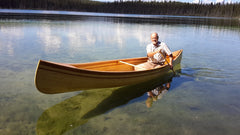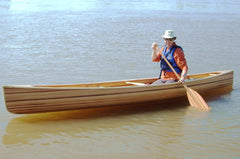A Week in the Little Creek Workshop, by Pascal Murphy and Sarah Jean Harrison

“So…you’re driving from Toronto to Vermont to spend a week building a canoe with a guy you met for 2 hours 12 years ago?” my neighbour asked.
I smiled. “Yep.”
12 years ago I was driving through the Green Mountains of Vermont when I saw a small road sign for Little Creek Canoe and Kayaks. 2 hours after turning down that dirt road, I had bought the most beautiful handmade wooden canoe I had ever seen from master craftsperson and wooden boat builder, Phil Pike.
1 year into COVID and I was paddling my beautiful canoe on the Humber River every weekend. 6 months after that I called Phil to say “I owe you a long overdue thank you.” 2 phone calls later and Phil had agreed to take me on as an apprentice.
Was I nervous? Oh yes. Who camps out in a sleeping bag on a living room floor in the backwoods of Vermont for a week, with no cell reception or internet, for boat building lessons? Didn’t YouTube make this unnecessary? Was I nuts? But more importantly, how nuts was the person who invited a stranger to sleep on their living room floor for a week?
***


In Phil’s living room, side by side, there are 2 kayaks and me in my sleeping bag.
It’s 6am and I hear Phil get up and head for the shop. I follow his pace, knowing that at nearly 70 he’s worked like this since he was a kid on the farm. I can see long hours written in his slight limp and strong, bent hands. Life hasn’t handed Phil anything without first demanding payment in labour.
On day one, after showing me around the shop, Phil had looked at me and said “You’re gonna learn how to build a Rice Lake Skiff.”
I was thrilled. I was nervous. I was…wondering what the hell was a Rice Lake Skiff? Wasn’t I here to build a canoe?
Phil had walked me through the plans for the skiff. It was a family-sized wooden row boat that can handle a small motor. Slowly it comes together in my mind: skiff, canoe or kayak the principles and skills of wooden boat building are the same.
Four days in and the skiff is progressing to the cove and bead strips. Phil is incredibly particular with his process. First, measure and match the grains. Then sand, glue, clamp, and wedge. Examine carefully and repeat. As you go, return every tool to its home, sharp and clean. Correct every mistake.
Phil’s from a family of dairy farmers, born and raised in the Green Mountains. He joined the Navy, twice, and traveled the world. He built and repaired huge highway culverts that were prized by county inspectors. He loves historical reenactments and has taught himself how to brain-tan deer hides and make gunpowder for muzzle-loaders.
Between his stories, which are an even split between heartwarming and terrifying, he’s watching my work closely. Nothing escapes his notice. He doesn’t hesitate to tell me that if I make a mistake with the glue it all has to be removed and it doesn’t matter how long it takes.
I look back down at the glue bottle in my hands and lean in closer.
***


The skiff was taking shape on the strongback and I had avoided any glue disasters. I knew I was doing well when Phil asked me to tell him some stories. He was confident enough in my work that he could afford to listen rather than talk.
I launched into stories of love, adventure, and canoeing. I told him about hiding a cat in my closet when I was 10 years old and how I fessed up when my mon asked me where all the cans of tuna had gone. I told him about climbing Mount Kilimanjaro with a broken heart. I told him about paddling around the Toronto Islands this summer and how I almost capsized in the Island Airport flight path.
And I asked him one question: would he guide me through refinishing the canoe I had bought from him 12 years ago?
He smiled, gave me his most enthusiastic okay! and pulled out the orbital sander. The instructions were clear. Carefully sand off just the paint. Do not sand through the fiberglass.
Demonstrating briefly, he sanded a small section, carefully removing only a millimeter of paint. I understood that this would be difficult and slow but I was excited. Sander in hand, I started in.
Hours later, with sore shoulders and a creaky neck. I paused. I had removed less than a few feet of paint. The canoe was 17 feet long. I was going home in 2 days.
Phil walked over to survey my work. He was pleased with my sanding but something was bothering him. “I think you’re going to have to repaint,” he said. “Really?” I sighed. “I know it’s slow but if I focus and power through, I think I can make it.”
He looked down the length of the boat. “I have a confession to make,” he said.
My eyes widened, possibilities tumbling through my mind as a I set down the sander. He turned to me and took a breath.
“This was the second boat I made for myself. I’d made a few others that didn’t turn out but this one was perfect.” He paused. I listened to the silence of the shop. He set his hands on the curve of the bow.
“When I was finishing it an oil stain showed up in the wood. I’ve never figured out where it came from. I tried to sand it out but couldn’t get it. So I painted the boat.”
“Do you remember where it is?” I asked. “Yep,” he said and pointed to a spot on the port stern. “Let’s see it,” I replied.
I started to sand the section. It had clearly already been sanded and it was difficult not to hit the fiberglass. An hour later we were both staring at a slight discolouration smaller than a salad dish. In my mind I had seen a glaring dark oil slick the size of a hubcap marking the beautiful golden wood. This hardly counted as a blemish let alone a stain.
I started to laugh. Phil looked at me confused. “I’m sorry, Phil,” I said. “But this isn’t a stain. It’s a birth mark. It’s a reminder that a person made this boat. And now that I know you, I can’t cover this up. It makes me love the boat even more.
He smiled slowly. “Then you’d better get back to sanding.”
***


I woke up on my last morning with Phil and decided we needed to celebrate. I headed into town to pick up something special for breakfast. Phil went to see the canoe. Every boat that leaves his shop is saged and given his blessing.
Over breakfast we talked about our favourite places to paddle and the wildlife we had seen. We talked about how gorgeous the canoe looked and how well the skiff had progressed. He had nearly finished the skiff while I had worked on my canoe. I mentioned, ruefully, that he moved faster without me to direct.
I thanked him for taking me on as his apprentice. For his generosity and big heart. For being an excellent teacher. For letting a stranger come sleep on his living room floor.
When the canoe was on the car, strapped in and double checked, we both knew it was time for me to go. We had spent eight days working, laughing, and learning in the quiet of his shop. He had shared his stories with me, introduced me to his friends and neighbours, welcomed me into his life. We had become friends and I was honoured by the title.
I decided to take a risk. “I know guys aren’t supposed to say this,” I said, “but I love you.”
“I love you too,” he said as the tears welled up.
I gave him a long hug, smiled and said “now I’m going to go because I’m going to cry.”
He nodded, turned, and walked back into the shop. I started the car, let the tears come, and pulled away.




